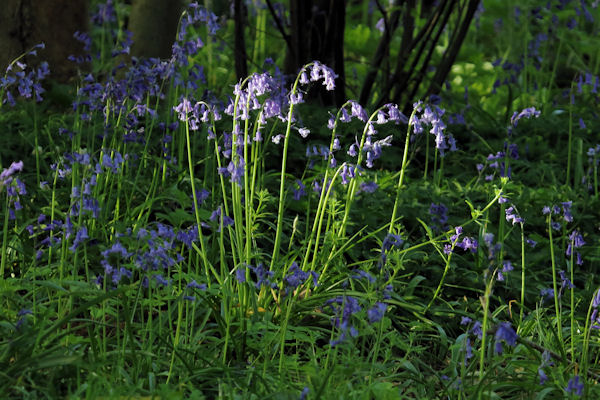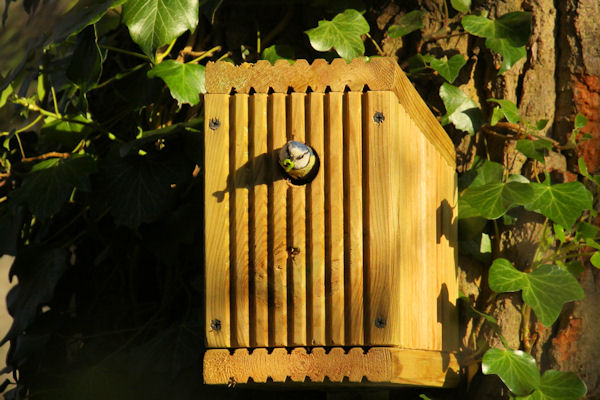May 2022 in Bicknor Wood
The dryness of April was finally relieved during the third week of May with a few wet days which saw the wood steaming with damp warmth. The month started with a blanket of bluebells beneath a blue sky, but the bluebells passed over as the month progressed and the sky was blocked as the Sweet Chestnut gained their leaves and cast the woods into shadow.
There can hardly be anything so spectacular as the spread of Bluebells in a spring woodland, but by the second week of the month, they were beyond their peak and were completely gone before the end of the third week. Red Campion has been flowering since the beginning of the month, but cannot rival the abundance, the intensity, nor the fragrance of a mass of Bluebells.
The next widespread flowering will come from the brambles which were first seen opening on May 24th. The foxgloves appear to be fewer in number this year, with just a very few spires dotted around.
A walk on May 12th revealed that 12 of the nest boxes were hosting chicks. Ten pairs of Blue Tits were seen feeding chicks at 1, 6, 7, 9, 12, 13, 15, 17, Snoop25 and 27.
Great Tits were seen at 5 and 28.
Box 22 received an official snub from a pair of Blue Tits using a natural hole just around the trunk. Another natural Blue tit nest was seen in the oak tree close to box 8.
Activity at box Snoop25 went quiet after May 15th and is likely to be the earliest fledging from the boxes.
Feeding was first observed on April 27th at no. 6. Blue Tit chicks usually fledge after 18-21 days, so when the box went quiet on 16th, it can be reasonably assumed that the chicks had fledged. Another nest of Blue Tits in box 27 and the two pairs of Great Tits in 5 and 28 also fledged that day.
By May 24th, only 5 (7, 9, 12, 13 and 17) of the 12 boxes were still active, but another box, no. 4 had been added.
Box 1 fledged on May 21, the last activity from box 15 was on 18th. and Snoop25 is believed to have fledged on the 15th.
Chicks from the natural nest in the oak near the new pond were seen and photographed on 24th. Box 13 also fledged on 24th. Box 9 fledged on 27th
By May 30th, all the boxes had gone quiet. 12 and 17 had been feeding for the full term and it would be fair to say that they probably fledged. Boxes 4 and 7 had only been under observation for a week. It is quite possible that the nest building and the early spell of feeding chicks could have been missed. There was no damage to the boxes, so no reason to suspect that they didn't also fledge successfully.
Where have the woodpeckers been hiding during all this? During April, one could barely step into the wood without hearing the drumming of the Great Spotted Woodpecker, but they went strangely silent for the first half of May. The burgeoning leaves made it more difficult to see them. An incubation time of 10-16 days might help explain what they have been up to. The female will do the majority of the brooding, but the male was still conspicuous by his absence.
After a quick flypast on May 5th, it wasn't until the 17th that I caught a glimpse of the female as she slunk back into her chosen nesting hole, but it was a further 4 days before the male was seen at the nest. Since then he has been doing his duty, but has been keen to allow the female to take over as soon as she returns from feeding.
Blackbirds, Dunnock and Song Thrush have been seen carrying food into the Brambles in the western end of the wood. It is difficult to get a close view of their nests without disturbing them, so there are no photographs.
Robins and Wrens are very active in the east. Their boxes are hidden, so confirmation that they are being used will have to wait until box cleaning day. Blackcaps were seen feeding nests in 2 locations (24th) low down in the brambles. A young Chiffchaff was seen on 19th when it crash landed into low brambles and was coaxed out by an anxious parent. Robins were seen carrying food on 18th and a chick was seen being fed on 28th.
Woodpigeons and Collared Doves and Magpies have all been seen on nests, which brings the number of confirmed breeding bird species in Bicknor Wood this year to 12. That number is likely to be higher with Mistle Thrush having been heard calling and seen carrying nesting material. A family of Long-tailed Tits were seen Will o' the wisping, corkscrewing up into a hawthorn on 28th. Jays are probably breeding here too.
The Rabbits and Jays continue to frustrate my attempts to get a clear picture.


























Comments
Post a Comment